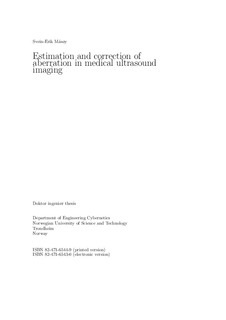| dc.description.abstract | The work presented in this thesis is devoted to studying aberration in ultrasound medical imaging, and to provide methods for correcting aberration of ultrasound signals in order to obtain optimum image quality. The thesis is composed of five chapters. All chapters may be read individually. The presented results are generated from simulations.
Chapter 1 presents a description of the aberration phenomenon, and a brief discussion of its medical and practical implications. A mathematical description of aberration is introduced by modelling the Green's function for propagation in a heterogeneous medium.
In Ch. 2, aberration from a point scatterer in the focus of an array is studied. Aberration is generated by two body wall models, generating weak and strong aberration, emulating the human abdominal wall. The results show that if correctly estimated, aberration can be close to ideally characterized by arrival time and amplitude fluctuations measured across the receive array. Using the arrival time and amplitude fluctuations in a time-delay and amplitude transmit aberration correction filter, produce close to ideal correction of the retransmitted beam. A point source represents a situation which is rarely found in medical ultrasound imaging.
A method for estimating aberration from random scatterers is developed in Ch. 3. The method is based on a cross-correlation analysis, and may in general estimate aberration at each frequency component of the received ultrasound signal. Due to the results from Ch. 2, the method is only investigated for a time-delay and amplitude estimate at the center frequency of the signal. The same aberrators as in Ch. 2 are used. The results show that the method does not produce satisfactory estimates of the arrival time and amplitude fluctuations for both aberrators. The backscatter in ultrasound imaging is determined by the width of the focused transmit beam used to obtain the image. Aberration widens the transmit beam, and the back-scattering region may become quite large. Since the human body wall has a certain thickness, the body wall itself generates interference of the signals propagating from different scatterers to the array. This smoothens aberration parameters such as arrival time and amplitude fluctuations, making proper estimation of these unfeasible.
Aberration correction is performed as a filter process prior to transmit of the ultrasound beam. This means that aberration estimation/correction methods model aberration as a filter, that is, all effects of aberration are assumed to be fully described in an infinitely thin layer at the array surface. For a point source, this assumption is fulfilled since the signal received on different array elements originates from the same spatial point. For a large scattering region this is generally not true, and the aberration described on a specific array element is dependent of the sum of aberrations generated along different propagation paths from each contributing scatterer. It is then impossible to obtain ideal aberration correction for a specific point in space (usually the focus of the array).
A solution to this problem may be sought by iteration of transmit-beam aberration correction (transmit-beam iteration). Transmit-beam iteration is described as a process where an uncorrected transmit-beam is used for an initial estimate of aberration parameters. A new beam with correction is then transmitted, generating a new estimate of the parameters. This process is repeated until some convergence criterion is met. The goal of this process is to reduce the width of the transmit beam, in order for the aberration on a specific receive element to be independent of the scatterers spatial position.
Transmit-beam iteration is studied in Ch. 4. Now, eight different aberrators are used, all emulating the human abdominal wall. Here, the estimator developed in Ch. 3 is compared with a similar type of estimator. New insight into the equalities and differences between the estimation methods are provided through transmit-beam iteration considerations. The results show that using a time-delay and amplitude aberration correction filter, both algorithms provide close to ideal aberration correction after two to three transmit-beam iterations for all aberrators. In addition, an earlier developed focus criterion proves to give accurate description of the point of convergence, and the accuracy of the correction.
The aberration estimation method described in Chapter. 3, was developed in the frequency domain. In Ch. 5, a time domain implementation is introduced. Necessary assumptions made in the time domain implementation makes the algorithm different from the frequency domain implementation.
Since the receive signal in ultrasound imaging is a stochastic variable, estimation of arrival time-delays and amplitudes at the array, is connected with uncertainty. A variance analysis of both the time and frequency domain implementations is performed.
There exists only minor differences between the two implementations with respect to variance. The variance in the estimates proved to be highly dependent upon the aberrator. Results also indicate that a transmit-beam iteration process converges, even if the variance in the initial estimate for the iteration process is very high.
In appendix A, a brief discussion of aberration as a function of frequency is provided. | nb_NO |
